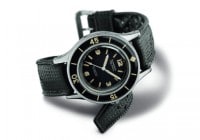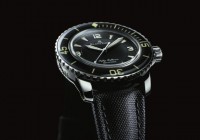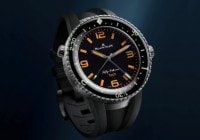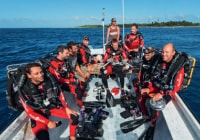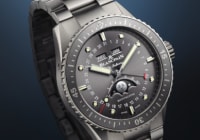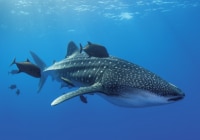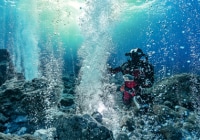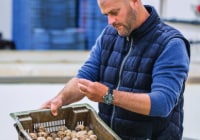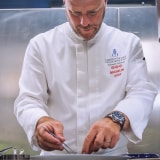
Search in Issues
Chapters
List of parts
Chapter 9
Christopher COUTANCEAU
Michelin sees three stars. Christopher Coutanceau sees himself as a “chef-fisherman”.
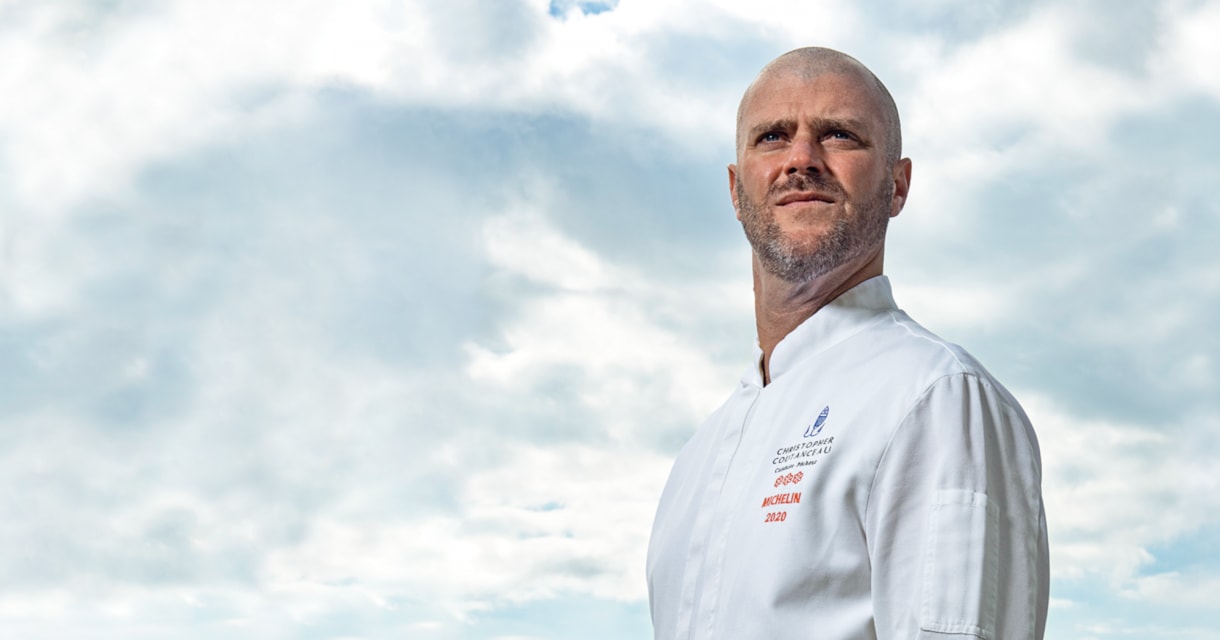
EVERY DAY begins at the “criée”, which is what the French call THE FISH MARKET.
It begins every day at the criée. “Criée” is the French word for what is essentially a cross between a wholesale fish market and commodity exchange. The name derives from the practices of the past. Well before dawn, fishermen arriving back at port from their evening’s labors at sea would lay out their bounty in bins and troughs. In common with exchanges the world over, the medium for offers and bids was the shout, barked announcements of lots, bellowed replies. As the French word for “shouting” is “crier”, that word affixed itself as the name for this market/exchange. Today, while not completely reverential, relative quiet prevails as the shouting has been replaced by an electronic system for posting lots and registering bids for the just-arrived fish. That touch of modernity aside, the rituals remain largely the same. Each morning, Chef Christopher Coutanceau or one of his two senior chefs head to the La Rochelle criée to purchase that day’s selection of fish for his three-star Michelin restaurant, itself located adjacent to the harbor.
Chef Coutanceau describes himself as a “cuisinier-pêcheur” (chef-fisherman). The latter word may not directly signal his devotion to the ocean and its preservation, but when read against his upbringing, that connection becomes clear. When he was young, fishing taught by his grandfather was important in his life. Like all talented fisherman, he learned to read the water and, by extension, developed a deep understanding of marine life itself. His close examination and awareness of the ocean and its ecosystems kindled his commitment to preservation and sustainability. In this, he makes common cause with Blancpain and our multi-faceted Ocean Commitment environmental initiatives.
Many in the food world have adopted the mantra of sustainability and environmental protection. But what do the pronouncements of sustainability really mean? Is it simply greenwashing, or is it backed by deep study and reflection actually leading to positive initiatives? For Coutanceau, his analysis has bred a multifaced notion of sustainability actions. He is animated when speaking of his dedication to ocean preservation, and almost immediately jumps to one prong of his commitment that is overlooked by many: seasonality. The yearly calendar, married to his knowledge of marine lifecycles, signals which particular species of fish can be consumed and when. Indeed, his recently released cookbook is entitled “Les Saisons de l’Océan” (“The Seasons of the Ocean”). How are the seasons of the ocean connected to sustainability and protection of the resource? A few examples illustrate the links. Throughout Europe, bar de ligne (several related species of sea bass) is found on restaurant menus and in fish stalls year-round. However, the critical period for bar reproduction spans from January through April. To help ensure vital propagation of these species for the future, Coutanceau avoids offering bar during those important breeding months. Similar reasoning lies behind his selection of langoustines. They are featured in his repertoire only from June through October, leaving them to reproduce during the other months of the year. Likewise, he restricts preparation of Saint-Jacques (scallops) to the period October through April.
Of course, seasonality is not a concept foreign to gastronomy. After all, no one lusts for winter tomatoes. They have a season in summer and early fall. Likewise, there is a season for wild mushrooms. Milk-fed lamb comes in spring. The list is long. But there is more to Coutanceau’s seasonal credo. For fruits and vegetables, seasonality links to the periods when the produce is at its best. There is no risk that tomatoes will become extinct if eaten “off peak”. The seasons he respects for fish are more profound. They are inextricably tied to the preservation of fragile resources.
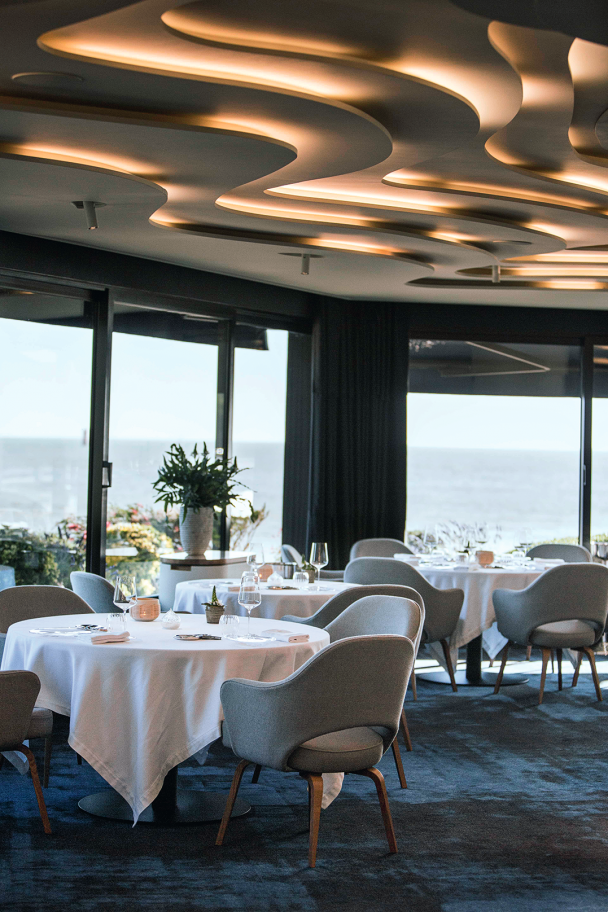
Coutanceau brings the ocean front and center into the dining room.
Michelin has accorded Coutanceau its SUSTAINABLE GASTRONOMY AWARD in addition to his THREE STARS.
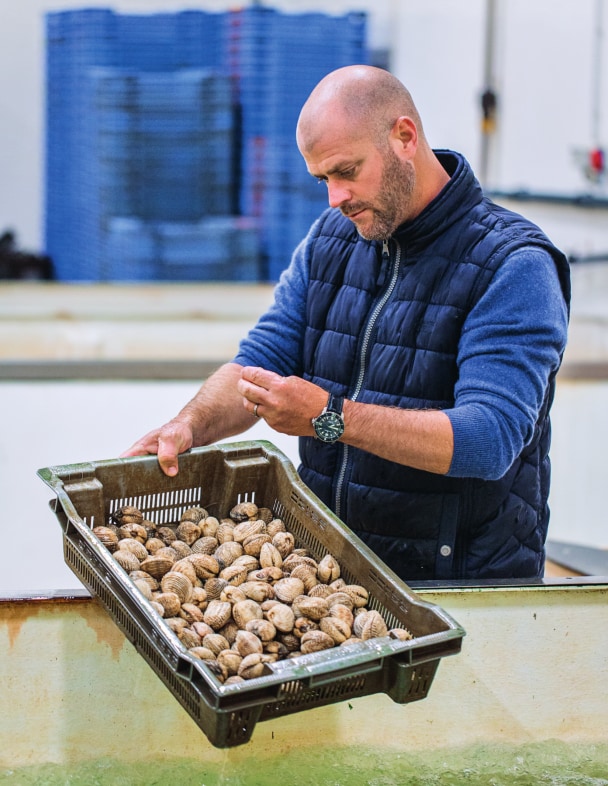
A morning inspection at the criée by chef Coutanceau of the day’s clam catch.
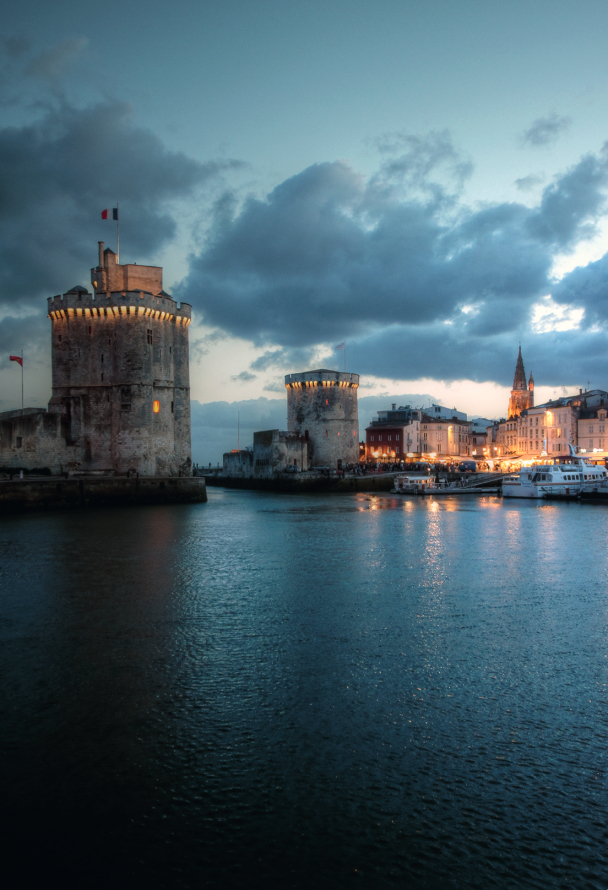
The fortresses guarding the entrance to the La Rochelle harbor.
Fishing methods are also in the forefront of his environmental thoughts. To help preserve the bar population, he only selects line-caught bar which have an age of four to five years. Unlike fish caught in a net, young line-caught bar can be released back into the ocean. Because they are released, the young, smaller bar can reproduce for several more years. In the same way that he favors line-caught bar over net-trapped bar, he denounces electric and explosive systems of fishing. Not only are these methods unselective in the fish that are subject to them, needlessly killing fish not suitable for consumption, the fish that are desired are diminished in quality by the stress associated with these methods.
His dedication to ocean protection extends even further when the subject of plastics comes up. Recognizing that plastics break into microparticles that are ingested by marine life, he has taken up the cause of preventing plastics from entering the sea.
With the second half of his self-description as “cusinier-pêcheur” pointing toward his commitment to ocean preservation, there is equal gravitas in the first half: cusinier. His training as a chef began at the École hôtelière (Hotel School) in La Rochelle. What followed were ports of call with many of the greatest chefs of our time: Joël Robuchon, Denis Martin, Ferran Adrià, Jean Bardet, Gaston Lenôtre, Pierre Hermé, and Alain Ducasse. Following these apprenticeships, he returned to La Rochelle to work alongside his father who had achieved two Michelin stars. At the time, his father’s restaurant was not exclusively a fish restaurant and, following the purchase from his family in 2007, Christopher Coutanceau initially preserved a similar style menu. That all changed in 2017 when Coutanceau completely transformed both the interior of the restaurant and its focus. Not only did he revise the menu to center upon the ocean, he also added the further imperative to offer local seafood only. His third Michelin star arrived quickly in 2020. Michelin bestowed a further honor upon Coutanceau. In the inaugural year of the accolade’s creation, Michelin recognized Coutanceau with its Sustainable Gastronomy award.
Entering the restaurant brings the ocean theme front and center. One is greeted by a wall of windows oriented to the sea and a ceiling evoking waves. Even the arrangement of the tables suggests a calm sea. An impressive parade of small appetizers settles the diner into the meal. Coutanceau styles these as Bouquets vivants en fine gelée, plantes marines. Immediately, he has signaled one of his signature touches. For many of his preparations, he prefers to use ocean plants for vegetal notes. The first small appetizer is a case in point; it is a gelée of mackerel and oysters in the form of a disk colored and spiced by algae. It is followed by three ethereal pairings: crab and grapes with verjus, a delicate tartare of bar with mushrooms, and langoustine cooked in butter offset with the earthy notes of a cèpe emulsion and chestnut.
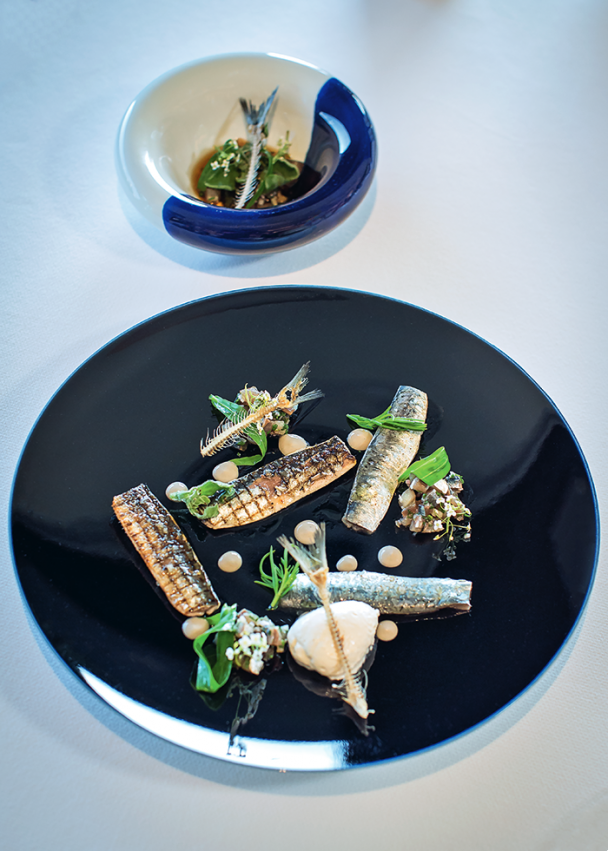
Sardines from the head to the tail.
SEASONALITY is one of the pillars of Coutanceau’s dedication to SUSTAINABILITY and ENVIRONMENTAL PROTECTION.
A dawn visit to the criée forecast other appetizers for that evening. Scanning that day’s tubs, Coutanceau spied a gorgeous selection of small rouget (red mullet). With not an instant’s hesitation, a box was organized for him. Another inspiration came from a lot of bigorneaux (periwinkles).
One entrée emblematic of the house and demonstrating his environmental sensitivities is sardine de la tête à la queue (sardines from the head to the tail). Four sparkling fresh large sardines are presented with multiple preparations, and the imperative that none of the sardine should go to waste. The main part of the bodies, with two cooking methods, dominates the plate: two are grilled and two marinated. The head has not been forgotten; it forms the base of the vinaigrette sauce. Even the bones are not wasted as they are deep-fried, lending a delicate chip-like crunch to the dish. Finally, on the plate is a tartare of sardine with ocean vegetables. Along- side is a dashi-style bouillon of sardines with algae. The ensemble is a graduate course in the glory of sardines. It is as if Coutanceau is conducting a lecture— “look at this...now experience that...” —illustrating the different dimensions of sardines as each bite reveals another expression of the fish.
The lofty perch of three Michelin stars demands virtuosity of technique. The November tasting menu showcased Coutanceau’s range. Shrimp, scallops, monkfish, eel, and oysters dramatically demonstrated the breadth of his prowess.
Delicacy of touch marked the crevettes. The barely cooked shrimp, coated with shrimp gelée, are served with tapioca powder and sea lettuce. Nothing is left to waste as the diner is encouraged to eat the heads along with the body. The flavors simply explode on the palate.
For the scallops, he coaxed three distinct personalities from the shellfish: a plump, lightly grilled body, crisped scallop foot, and a carpaccio with lime. The accompaniments were unexpected, featuring a deeply colored and concentrated chicken stock accented with tarragon, a grilled disk of celery root, and a lime sorbet. Truly a triumph presenting the main ingredient from multiple perspectives.
Root vegetables, which marked one of the scallop preparations, made another appearance with the monkfish: Lotte à la broche: carbonara de courge et coques, fumet au caviar Kristal. Carbonara is not a signal of Roman pasta. Instead, it refers to the colonnata (subtly smoked lard from the Northern Italian village of the same name) wrapping of the monkfish. The fish fumet-butter sauce studded with caviar works as a bridge between the monkfish and a grilled rectangle of winter squash.

Three preparations of scallops: lightly grilled body, crisped foot, and carpaccio accented with lime.
DELICACY OF TOUCH is one of the HALLMARKS of Coutanceau’s cuisine.
Entirely different techniques were on display with his miraculous preparation of eel: Anguille et jaune d’oeuf de poule à l’hélichryse, poireaux. The dish offers a symphony of savors and textures: the eel delicately smoked, the egg yolk bringing richness, the leeks offering sweet notes, and the white balsamic vinegar as a counterpoint to the richness of the eel and egg. The egg yolk itself made its own statement setting itself apart from the commonplace, as it had been poached at room temperature in the white balsamic vinegar, resulting in a seductive, unctuous texture.
How often are oysters offered as a main course? The world over, they are almost universally consigned to the overture of a meal. Whatever the injunction against their greater prominence as a main, Coutanceau sees them differently with his Huîtres Fines de Claire: au feu de bois et choux-fleurs, marine, curry, mertensie. The oysters are presented in three different ways: grilled, poached, and tempura with algae butter. Even the cauliflower is given two roles: one grilled with touches of curry, the second pickled. Uniting all of this is a dense, rich, and dark duck sauce.
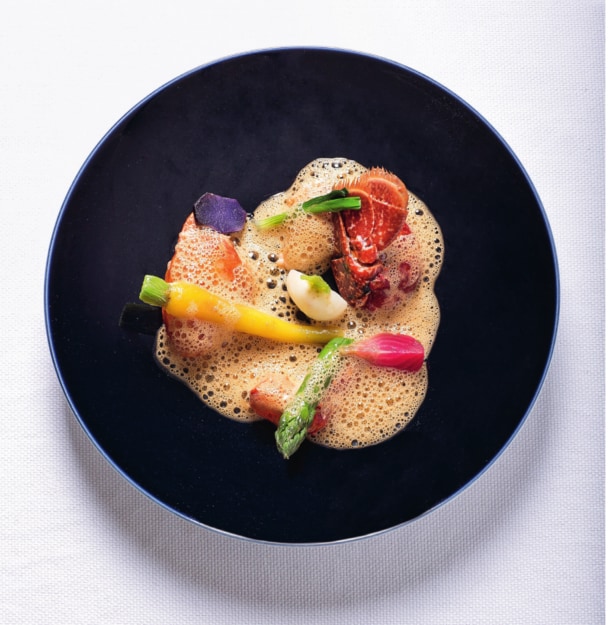
Lobster Civet gourmand de homard Breton pour mon papa, petits légumes de saison et raviole de champignons.

Even in a dessert there can be ALLUSIONS TO THE SEA, albeit playful, such as a buckwheat biscuit in the form of FISH BONES.
Coutanceau’s lobster is exemplary: Civet gourmand de homard Breton pour mon papa, petits légumes de saison et raviole de champignons. The preparation hues toward classicism, with fresh accents. The sauce starts as a traditional concentrated homardine livened with a hint of ginger. Carrots, fennel, and the mushroom ravioli play off the sweet lobster, cooked with precision to translucency. For those who lust for a lobster overdose, Coutanceau’s version is a must.
Rather than an abrupt jump from the sea to the desserts, Coutanceau has constructed a bridge. A plate, Coquillage glacé à la poire/dulse et gingembre, can be imagined as half and half. The sea and salty half features a dense ring of olive mousse surrounding a delicate algae-flavored nest bearing the sweet half, which is the ginger-accented pear purée. Both halves are represented with the iodée citrus foam crowning the ensemble.
Perhaps not half and half as with the pear, better thought of as three quarters/one quarter, the ocean notes carry over into the following Déclinaison d’agrumes de saison, arête au sarrasin, haddock fumé. The center-pieces were a passion-fruit and haddock sorbet and a citrus honey sorbet. Both poised upon a haddock powder and playfully topped with a buckwheat cookie in the form of fish bones. On the side were small orbs of a citrus-flavored pastry cream.
More traditional is the Soufflé à l’angélique/ Reine des Reinettes et verjus. Apple three ways: a classic soufflé with a perfect crisped caramelized top, served alongside, a green apple sorbet with lime nestled within a hollowed-out apple, and dried apple-skin chips with almonds.
The coda for every visit is an armada of intense chocolates and salty caramels.
With its intimate harbor guarded by three stone fortresses and labyrinth of street arcades, La Rochelle has always beckoned as a seductive seaside jewel. Its attractions shine even brighter now that Coutanceau has given La Rochelle no less than France’s finest seafood restaurant.
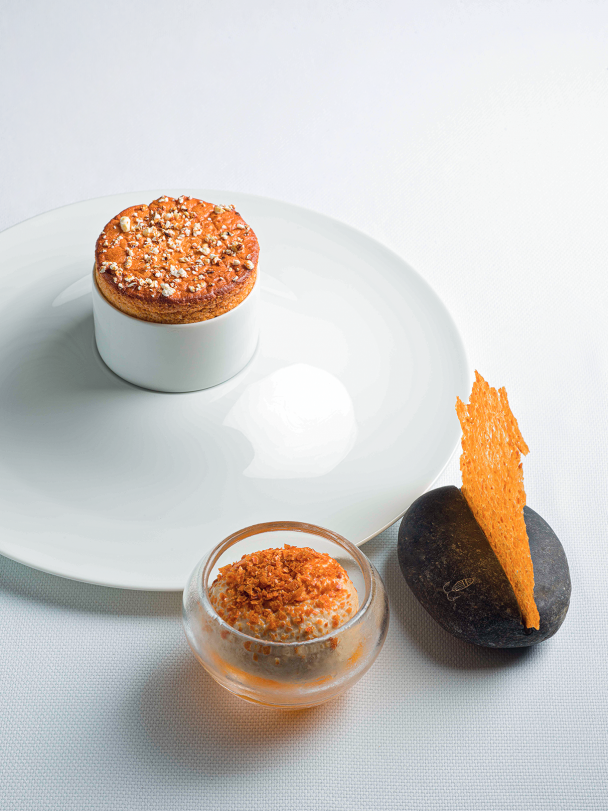
Apple three ways with a soufflé, green apple sorbet, and a dried apple skin chip with almonds.
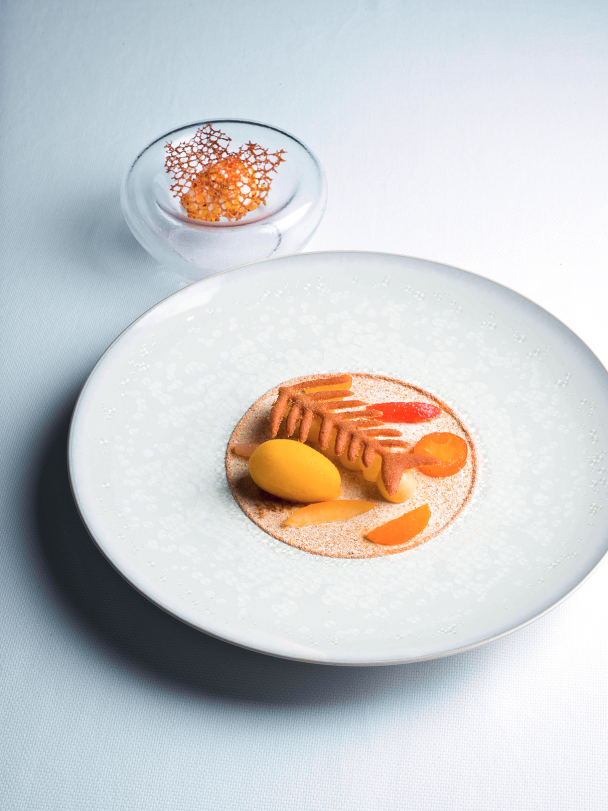
Other issues
Don't miss the latest issue
Sign Up for New Releases

